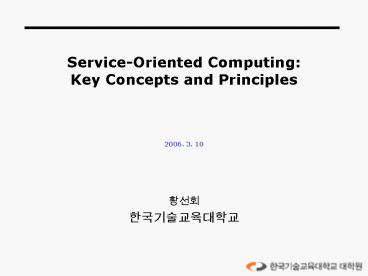ServiceOriented Computing: Key Concepts and Principles - PowerPoint PPT Presentation
1 / 15
Title:
ServiceOriented Computing: Key Concepts and Principles
Description:
The architecture for Web services provides a framework that can be fleshed out ... A downloaded Java applet could synchronize with the server after the broken ... – PowerPoint PPT presentation
Number of Views:98
Avg rating:3.0/5.0
Title: ServiceOriented Computing: Key Concepts and Principles
1
Service-Oriented ComputingKey Concepts and
Principles
2006. 3. 10
- ???
- ?????????
2
Index
- Introduction
- Abstraction for SOC
- Service-Oriented Architecture
- Engineering an SOA
- Challenges for Composition
- Spirit of Approach
3
Introduction
- Most experts agree that Web will have to evolve
- Service-based applications has three main parts
- A Provider
- A Consumer
- A Registry
- The architecture for Web services provides a
framework that can be fleshed out with more
powerful representations and techniques taken
from established computer science approaches. - The articles in this track will thus emphasize
SOC concepts instead of how to deploy Web
services in accord with current standards.
4
Abstractions for SOC
- Hospital example
- Hospital systems provide services within an
enterprise, exemplifying the abstraction level of
intraenterprise interoperation. - Similar examples can exist among enterprises,
among software components, and between the
appllication level of a system and its
infrastructure level, as the following sections
dexcribe.
5
Abstraction for SOC Intraenterprise Abstraction
Level
- The first is connectivity aming the applications,
which protocols such as HTTP can readily ensure - The second is the ability of the various
components to understand each other - (XML Handle communication formatting, but it
cannot decipher) - SOA can organizationally enforce compliance with
these policies - A new problem arises then se want to introduce
new applications and configure them to
interoperate - SOC addresses these problems by providing the
abstractions and tools to model the information
and relate the models, construct processes over
the systems, assert and guarantee transactional
properties, add flexible decision
6
Abstraction for SOC Interenterprise Abstraction
Level
- Enterprises have interoperated in an ad hoc
manner that required substantial human
intervention. (EDI) - If a standard approach existed, robust commercial
tools could process the format rather than the
custom-software-based systems that are still
widespread. - SOC pprovides the ability for interacting parties
to choreograph their behaviros, so that each can
apply its local policies autonomously, yet
achieve effective and coherent cross-enterprise
rpocesses. - In addition, it provides support for dynamic
selectiong of partners as well as abstractions
through which the state of a business transaction
can be captured and flexibly manipulated
7
Abstraction for SOC Infrastructure Sofrware
Component
- Infrastructure Abstraction Level
- A Grid provides computing resources as a utility
analogous to electric power of telecommunications.
- Utility computing presupposes that diverse
computational resources can be brought together
on demand and that computations can be realized
depending on demand and service load. - Software Component Abstraction Level
- Programming abstractions that consider software
components to be potentially autonomous help
improve software development. - Services offer programming abstractions in which
software developers can create different software
modules through interfaces with clearer semantics
8
Service-Oriented Architecture
- Several SOAs can coexist, provided they satisfy
some key elements for SOC - Loose coupling (???)
- Implementation neutrality (?? ??)
- Flexible configurability (???? ??
configurability) - Persistence (???)
- Granularity (???)
- Teams
- SOAs address the fundamental challenges of open
systems, which are to operate efficiently and
achieve coherence in the face of component
autonomy and heterogeneity
9
Service-Oriented Architecture (cont.)
- Figure 1 . Web services architectural model. As a
basis for a service-oriented architecture, Web
services are advertised, discovered, selected,
and used
10
Engineering an SOA
- An SoA differs from a conventional architecture,
it requires a different development methodology
than CASE tools typically provide. - As shown in Figure2, a serivce-oriented
methdology replaces code generation with a
combination of service discovery, selection, and
engagement - Figure 3 presernets a different view of what is
involved in engineeering an SOA - Composite services apply in many practical
settings.
11
Engineering an SOA (cont.)
- Figure 2. Normative workflow. For the development
and execution of a Semantic Web service in a
service-oriented architecture, an appropriate
methodology must support the development of each
stat shown.
12
Engineering an SOA (cont.)
- Figure 3. Service-oriented architecture.
Engineering a service-oriented computing system
is a process of discovering and composing the
proper services to satisfy a specification,
whether it is expressed in terms of a goal graph
(top), a workflow (bottom), or some other model.
13
Engineering an SOA challenges for Composition
- Solving of some problems
- The server application could send email about
credit problems or detect duplicate transactions - A downloaded Java applet could synchronize with
the server after the broken connection was
reestablished and recover the transaction - To make processing robust against demand
fluctuation, orders could be put in a message
queue, which could be managed by message-oriented
middleware.
14
Engineering an SOA challenges for Composition
(cont.)
15
Sprit of the Approch
- To publish effectively, we must be able to
spectify services with precision and greater
structure. - Service requestors should then be able to find a
registry that they can trust, which means dealing
with considerations of trust, reputation,
incentives for registries, and, most importantly,
for the registry to understand the requestors
needs.

